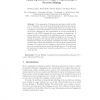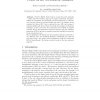120 search results - page 18 / 24 » Disjunctive Logic Programming and Autoepistemic Logic |
ICLP
2003
Springer
14 years 8 days ago
2003
Springer
In recent research on nonmonotonic logic programming, repeatedly strong equivalence of logic programs P and Q has been considered, which holds if the programs P ∪ R and Q ∪ R h...
ICLP
1994
Springer
13 years 11 months ago
1994
Springer
In many cases, a logic program can be divided into two parts, so that one of them, the \bottom" part, does not refer to the predicates de ned in the \top" part. The \bot...
ILP
2007
Springer
14 years 1 months ago
2007
Springer
The management of business processes has recently received a lot of attention. One of the most interesting problems is the description of a process model in a language that allows ...
AIIA
2007
Springer
14 years 1 months ago
2007
Springer
Logic Programs with Annotated Disjunctions and CP-logic are two different but related languages for expressing probabilistic information in logic programming. The paper presents a...
CADE
2006
Springer
14 years 7 months ago
2006
Springer
Church's Higher Order Logic is a basis for proof assistants -- HOL and PVS. Church's logic has a simple set-theoretic semantics, making it trustworthy and extensible. We ...


